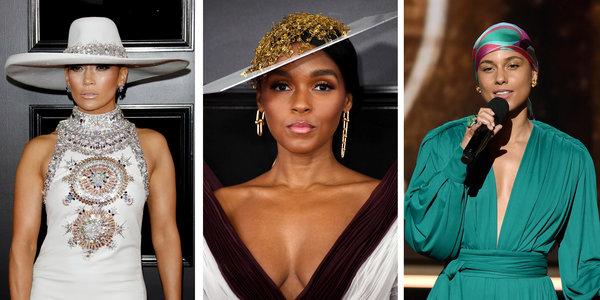It’s possible that the most out-there moment of fashion week took place Sunday night thousands of miles away from the New York catwalks — sorry, red carpet — at the Staples Center in Los Angeles.
I am speaking, of course, of Cardi B’s Grammys entrance as Venus emerging from her clam in vintage Thierry Mugler (circa 1995), her top half covered in a nude body suit and molded bustier, her bottom half in black velvet that exploded into a pink satin abalone frame around her pearl-encrusted waist.
It was a little absurd and a little unwalkable and deep in the realm of costume. (She later changed into another vintage Mugler, an off-the-shoulder white gown with floor-length fringe, the better to make it to the stage to accept her Grammy for best rap album.) But as an image of female potency and coming into one’s own, it was impossible to miss.
Sometimes, you’ve just got to get out of your shell.

From left: Jennifer Lopez, Janelle Monáe and Alicia Keys.CreditFrom Left: Nina Prommer/EPA, via Shutterstock; Valerie Macon/Agence France-Presse-Getty Images; Kevin Winter/Getty Images for The Recording Academy
Along with Janelle Monáe’s flying buttress Jean-Paul Gaultier minidress and flying square hat, it was a reminder that red carpet fashion is at its most arresting when it is about statement-making of the very personal kind — when clothing on the red carpet was unabashedly performative instead of protective.
Halfway through a fashion week in New York that, Telfar aside, has been notably sedate, and now that the film world seems to have effectively traded self-actualization for the economic security of brand marketing, it’s worth remembering.
Even if Lady Gaga, the former dress provocateur, seems to have blandified herself into haute Oscar acceptability. Was it only 2011 when she made her Grammys entrance in a translucent egg? She has gone from there to understated Saint Laurent column in eight years.
It’s a journey, of a sort — and one that is presumably her choice, which is the point. If she now wants to define herself in silver screen terms instead of meat dresses, that’s her prerogative. Though the jewel-encrusted unitard she wore to sing “Shallow,” which hinted at some of the looks of yesteryear, made me miss the more jaw-dropping moments.
Still, if there was any real takeaway from the Grammys fashion, it was the range of styles on display on a night that finally put women front and center.
Aside from Post Malone in his pink suit covered in rhinestone stars and Leon Bridges in his custom-made mustard Bode covered in personal totems, the men, who have been peacocking their way through the Hollywood awards season, were relatively restrained. (See: Drake in his black Tom Ford turtleneck and cashmere overcoat. See also: Donald Glover, who won a Grammy but didn’t even show up.) The women, however, did their own thing. Sisters, dressing the way they want to dress.
You could see it from the start, when Michelle Obama (Michelle Obama!) took to the stage in a hammered silver sequin Sachin & Babi wrap jacket and trousers — part armor, part lounge suit — continuing her post-White House/book tour-wardrobe breakout. She joined the host Alicia Keys, who did relative understatement (sure she changed clothes multiple times, but she also had a barefoot moment) in red and then teal green and then black; Gaga in her silver; Jada Pinkett Smith, who did old-time glamour in feathered Roberto Cavalli; and J. Lo, who did mystery in a giant white hat — all to celebrate the power of music.
And you could see it in Dolly Parton, who did herself in ruffly red and then body-hugging white lace and sparkles to perform. In Diana Ross, who did full-on diva in the stage-swallowing biggest dress of the night (she’s earned it). In Katy Perry, who did bulbous ruffles in pink Balmain (there was a lot of pink), which both made her look a bit like a hedge and was kind of toned down (for her). In Miley Cyrus and her tux (Mugler) and the yellow floral trouser suit she wore to perform with Dolly (Valentino couture). In the Coach jumpsuit with more than 25 kinds of crystals and paillettes that H.E.R. wore on the red carpet.
Like them or not, they spoke to the fact that music may be the last refuge of the fashion risk-taker. It’s one of the few celebrity-adjacent industries that has managed not to get indebted to the “ambassador of XX house” machine; where clothes still serve at the pleasure of the celebrity, as opposed to the other way around.
That is, after all, how they should serve us all.







